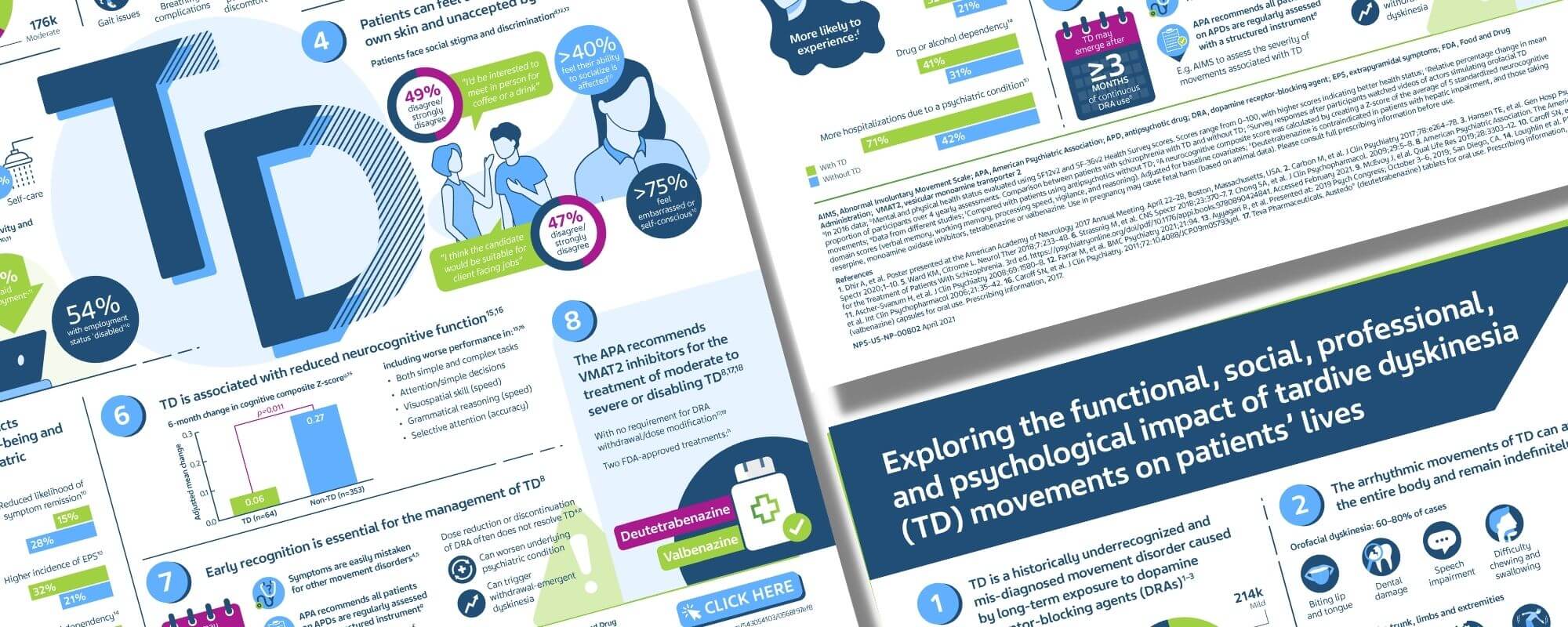
Exploring the functional, social, professional, and psychological impact of tardive dyskinesia movements on patients’ lives
Tardive dyskinesia (TD) is an historically underrecognized movement disorder with an incidence of more than 500,000 patients reported in the US in 2016.1–3 It predominately affects patients with psychiatric conditions that have been treated with antipsychotic drugs for more than a few months.2 TD causes neurocognitive and functional impairment but often has a wider impact on an individual's social and psychological well-being.4–9 While there are currently two FDA-approved treatments recommended for TD, it is vital that at-risk patients are regularly assessed for signs or symptoms of TD, to avoid misdiagnosis resulting in inappropriate treatment.10–12
TD is an underrecognized and typically misdiagnosed, drug-induced movement disorder1–3
TD is an often irreversible extrapyramidal side effect (EPS) caused by long-term exposure to dopamine receptor-blocking agents (DRA).1–3 The highest prevalence of TD has been reported among patients treated with antipsychotic medications, with approximately a quarter developing TD in their lifetime.1,3 The involuntary arrhythmic movements of TD often affect the face; however, in some cases these extend to the trunk, limbs and extremities.1,2,12,13 TD symptoms are chronic but may wax and wane in severity over time and have substantial impact on patients, even when considered mild.a,2,4,12
TD affects daily functioning and well-being5–7
The impact of TD movements on usual day-to-day activities, including eating and self-care can vary from 'a lot' to 'some' impact, but they frequently reduce quality of life.5,6 Many patients with TD experience lower productivity and fewer are in full-time employment than those without TD.5,6 They often feel uncomfortable in their own skin, with many feeling their ability to socialize is affected.5 Feelings of unacceptance and stigma may also develop as a result of discrimination by others.6,7 For instance, when shown videos of actors simulating orofacial TD movements, approximately 50% of responders would not be "interested to meet in person for a coffee or a drink" or disagree that " the candidate would be suitable for client facing jobs".7 Patients with TD can also experience negative impacts on their psychological well-being and underlying psychiatric conditions.4,5 Studies have found higher rates of EPS, drug or alcohol dependency, hospitalizations due to psychiatric conditions and reduced symptom remission in patients treated with antipsychotics with TD when compared with those without TD.9,14
TD is associated with reduced neurocognitive function8,9
In some cases, TD may be associated with severe psychopathology and cognitive impairment.8,9 When comparing patients with schizophrenia with and without TD, those with TD tend to score lower on neurocognitive tests reflecting functional ability in simple and complex tasks, attention and decision-making, processing speed, reasoning, and memory.b,8,9
Early recognition is essential for the management of TD2,12,13
TD presents in a similar way to other movement disorders, causing many patients to be misdiagnosed.2,13 To prevent this happening, the American Psychiatric Association (APA) recommends that all patients treated with antipsychotic drugs are regularly assessed for movements associated with TD using a structured tool, such as the Abnormal Involuntary Movement Scale (AIMS).12 The APA also recommends treatment with vesicular monoamine transporter 2 (VMAT2) inhibitors for anyone with moderate to severe or disabling TD. There are currently two FDA-approved VMAT2 inhibitors, deutetrabenazine and valbenazine.c,10–12 These therapies do not require DRA withdrawal or dose modification, which can worsen underlying psychiatric conditions and trigger withdrawal-emergent dyskinesia.10–12
aBased on mental and physical health status evaluated using SF12v2 and SF-36v2 Health Survey scores. Scores range from 0–100, with higher scores indicating better health status; bA neurocognitive composite score was calculated by creating a Z-score of the average of 5 standardized neurocognitive domain scores (verbal memory, working memory, processing speed, vigilance, and reasoning). Adjusted for baseline covariates; cPlease consult full prescribing information before use.

Dhir A, Schilling T, Abler V, et al. Estimation of Epidemiology of Tardive Dyskinesia Incidence and Prevalence in the United States. Presented at the American Academy of Neurology 2017 Annual Meeting. April 22–28, 2017, Boston, Massachusetts, USA; Poster 2.018.
Hauser RA, Meyer JM, Factor SA, et al. Differentiating tardive dyskinesia: a video-based review of antipsychotic-induced movement disorders in clinical practice. CNS Spectr 2020;1–10.
Carbon M, Hiseg C-H, Kane JM, et al. Tardive Dyskinesia Prevalence in the Period of Second-Generation Antipsychotic Use: A Meta-Analysis. J Clin Psychiatry 2017;78:e264–e278.
McEvoy J, Gandhi SK, Rizio AA, el al. Effect of tardive dyskinesia on quality of life in patients with bipolar disorder, major depressive disorder, and schizophrenia. Qual Life Res 2019;28:3303–3312.
Caroff SN, Yeomans K, Lenderking WR, et al. RE-KINECT: A Prospective Study of the Presence and Healthcare Burden of Tardive Dyskinesia in Clinical Practice Settings. J Clin Psychopharmacol 2020;40:259–268.
Ascher-Svanum H, Zhu B, Faries D, et al. Tardive Dyskinesia and the 3-Year Course of Schizophrenia: Results From a Large, Prospective, Naturalistic Study. J Clin Psychiatry 2008;69:1580–1588.
Ayyagari R, Goldschmidt D, Mu F, et al. An Experimental Study to Assess the Professional and Social Consequences of Tardive Dyskinesia. Presented at Psych Congress 2019; October 3–6, 2019, San Diego, California, USA; Poster 116.
Eberhard J, Lindström E, Levander S. Tardive Dyskinesia and Antipsychotics: A 5-Year Longitudinal Study of Frequency, Correlates and Course. Int Clin Psychopharmacol 2006;21:35–42.
Caroff SN, Davis VG, Miller DD, et al. Treatment Outcomes of Patients With Tardive Dyskinesia and Chronic Schizophrenia J Clin Psychiatry. 2011;72:10.4088/JCP.09m05793yel
Teva Pharmaceuticals. Austedo® (deutetrabenazine) tablets for oral use. Prescribing information; 2021.
Neurocrine Biosciences. Ingrezza® (valbenazine) capsules for oral use. Prescribing information; 2017.
American Psychiatric Association. The American Psychiatric Association Practice Guideline for the Treatment of Patients With Schizophrenia. 3rd edition. Washington, DC: American Psychiatric Association; 2021.
Ward KM, Citrome L. Antipsychotic-Related Movement Disorders: Drug-Induced Parkinsonism vs. Tardive Dyskinesia-Key Differences In Pathophysiology and Clinical Management. Neurol Ther 2018;7:233–248.
Loughlin AM, Lin N, Abler V, et al. Tardive Dyskinesia Among Patients Using Antipsychotic Medications in Customary Clinical Care in the United States PLoS One. 2019;14:e0216044.